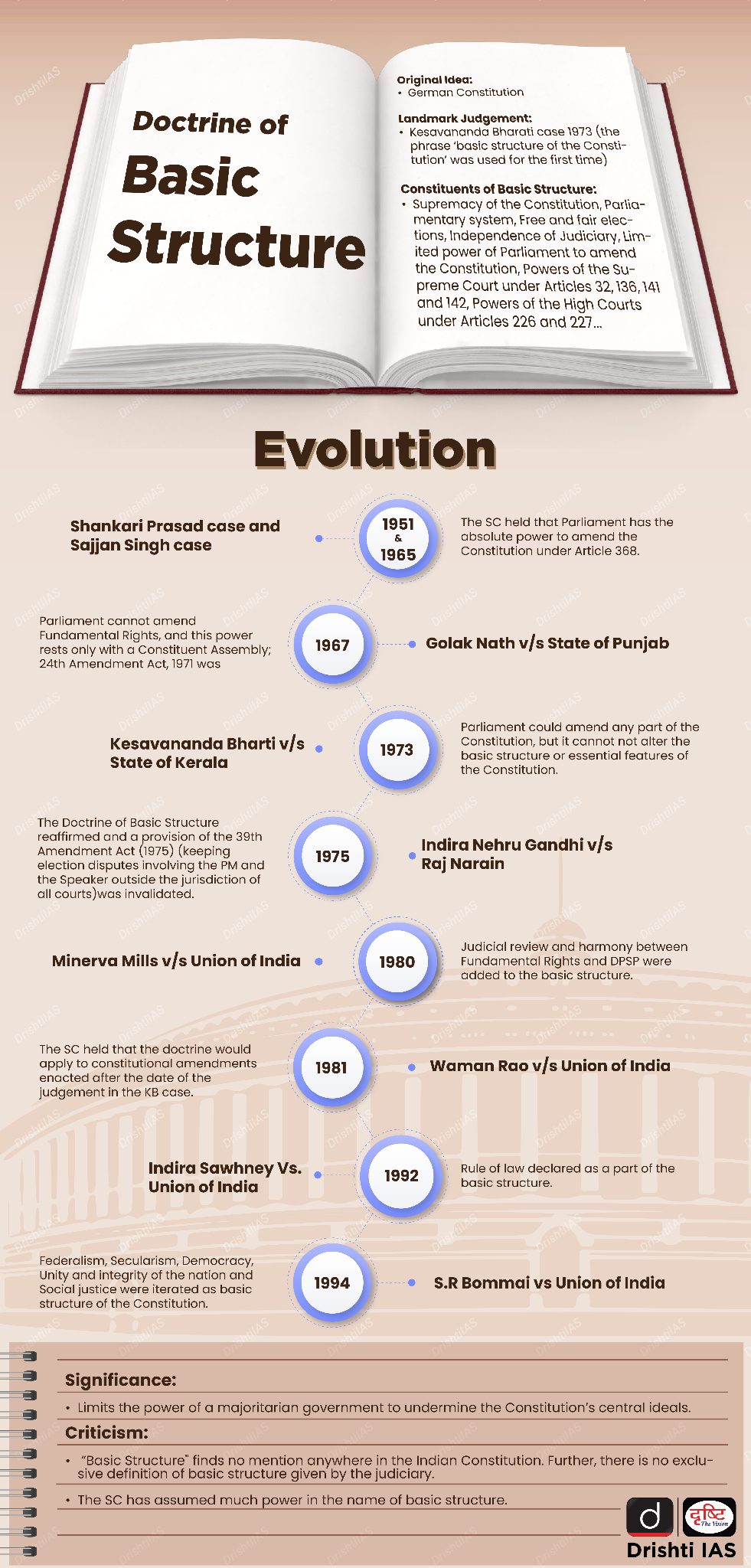Procedure of Amendment | 11 Jan 2019
Last Updated: October 2022
For Prelims: Parliament, Article 368, Amending Powers of Parliament, Basic Structure Doctrine, Kesavananda Bharati Case, Simple Majority, Special Majority
For Mains: Amending powers of Parliament and Basic Structure Doctrine
Why in News?
-
In 2019, the Parliament passed the Constitution (124th) Amendment Bill 2019 by a special majority.
-
The bill, however, saw arguments on the amendment procedure, including whether the Bill should be ratified by state Assemblies, and questions related to aided and unaided institutions.
-
What is the Procedure for Amending the Indian Constitution?
- Article 368 in Part XX of the Constitution deals with the power of parliament to amend the constitution and its procedures.
-
It states that the Parliament may amend the Constitution by way of addition, variation or repeal of any provision in accordance with the procedure laid down for the purpose.
-
However, the Parliament cannot amend those provisions which form the ‘basic structure’ of the Constitution. This was ruled by the Supreme Court in the Kesavananda Bharati case (1973).
-
- It provides for two types of amendments, that is, by a special majority of Parliament and the special majority of parliament along with the ratification of half of the states legislatures by a simple majority.
- Amendment of certain provisions of the Constitution requires amendment by a simple majority of each house present and voting. These amendments are not deemed to be amendments under Article 368.
What is a Simple Majority?
- A number of provisions in the Constitution can be amended by a simple majority of the two Houses of Parliament outside the scope of Article 368.
- These provisions include
- Formation of new states and alteration of areas, boundaries or names of existing states,
- Abolition or creation of legislative councils in states,
- Use of official language,
- Citizenship – acquisition, and termination,
- Elections to Parliament and state legislatures,
- Fifth Schedule – administration of scheduled areas and scheduled tribes,
- Sixth Schedule – administration of tribal areas.
What is a Special Majority?
- About:
- Under Article 368(2), Parliament can amend the Constitution by passing a Bill with a special majority.
- Fundamental Rights and Directive Principles of State Policy (DPSP) are the two most important provisions that can be amended by the special majority, but the amendments should be within Basic structure of the constitution.
- All provisions that do not require ratification by states, and those that come directly under the purview of Article 368, can be amended by the special majority.
- Special Majority with Consent of Half of States:
- Those provisions of the Constitution which are related to the federal structure of the polity can only be amended by a special majority of the Parliament and also with the consent of half of the state legislatures by a simple majority.
- Important provisions that require ratification by the states include the election of President, Supreme Court and High Courts, representation of states in Parliament, distribution of legislative powers between the Union and the states, and the extent of executive power of the Union and the states.
- Most importantly, an amendment to Article 368 itself, requires ratification by the states.
What are the Restrictions to Parliament’s Amending Power?
- In the landmark Kesavananda Bharati case 1973, the supreme court has ruled that parliament has the power to amend any part of the constitution but it cannot alter the “basic structure of the constitution”.
- The constituents of basic structure are not clearly defined by the court. However, it has been interpreted to provisions like values enshrined in preamble like secularism, equality etc., federalism, separation of power, independence judiciary, rule of law etc.
UPSC Civil Services Examination Previous Year Question (PYQ)
Prelims
Q1. Consider the following statements: (2013)
- An amendment to the Constitution of India can be initiated by an introduction of a bill in the Lok Sabha only.
- If such an amendment seeks to make changes in the federal character of the Constitution, the amendment also requires to be ratified by the legislature of all the States of India.
Which of the statements given above is/are correct?
(a) 1 only
(b) 2 only
(c) Both 1 and 2
(d) Neither 1 nor 2
Ans: (d)
Q2. Consider the following statements: (2020)
- The Constitution of India defines its ‘basic structure’ in terms of federalism, secularism, fundamental rights and democracy.
- The Constitution of India provides for ‘judicial review’ to safeguard the citizens’ liberties and to preserve the ideals on which the Constitution is based.
Which of the statements given above is/are correct?
(a) 1 only
(b) 2 only
(c) Both 1 and 2
(d) Neither 1 nor 2
Ans: (d)
Mains
Q1. “Parliament’s power to amend the Constitution is limited power and it cannot be enlarged into absolute power.” In light of this statement, explain whether Parliament under Article 368 of the Constitution can destroy the Basic Structure of the Constitution by expanding its amending power? (2019)
Q2. ‘The Supreme Court of India keeps a check on arbitrary power of the Parliament in amending the Constitution.’ Discuss critically. (2013)

